
Balthild, also spelled Bathilda, Bauthieult or Baudour, was queen consort of Neustria and Burgundy by marriage to Clovis II, the King of Neustria and Burgundy (639–658), and regent during the minority of her son, Chlothar III. Her hagiography was intended to further her successful candidature for sainthood.

A double monastery is a monastery combining separate communities of monks and of nuns, joined in one institution to share one church and other facilities. The practice is believed to have started in the East at the dawn of monasticism. It is considered more common in the monasticism of Eastern Christianity, where it is traceable to the 4th century. In the West the establishment of double monasteries became popular after Columbanus and sprang up in Gaul and in Anglo-Saxon England. Double monasteries were forbidden by the Second Council of Nicaea in 787, though it took many years for the decree to be enforced. Double monasteries were revived again after the 12th century in a significantly different way when a number of religious houses were established on this pattern among Benedictines and possibly the Dominicans. The 14th-century Bridgittines were purposely founded using this form of community.

The Archdiocese of Paris is a Latin Church ecclesiastical jurisdiction or archdiocese of the Catholic Church in France. It is one of twenty-three archdioceses in France. The original diocese is traditionally thought to have been created in the 3rd century by St. Denis and corresponded with the Civitas Parisiorum; it was elevated to an archdiocese on October 20, 1622. Before that date the bishops were suffragan to the archbishops of Sens.
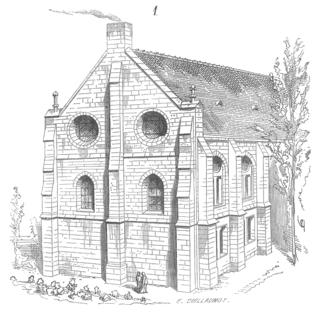
Gisela was a Frankish princess and abbess. There are also two variations of her name, which are Gisele and Giselle. She was the daughter of Pepin the Short and his wife Bertrada of Laon. She was the sister of Charlemagne and Carloman.

The Diocese of Troyes is a Latin Church ecclesiastical territory or diocese of the Catholic Church in Troyes, France. The diocese now comprises the département of Aube. Erected in the 4th century, the diocese is currently a suffragan diocese in the ecclesiastical province of the metropolitan Archdiocese of Reims. It was re-established in 1802 as a suffragan of the Archbishopric of Paris, when it comprised the départements of Aube and Yonne and its bishop had the titles of Troyes, Auxerre, and Châlons-sur-Marne. In 1822, the See of Châlons was created and the Bishop of Troyes lost that title. When Sens was made an archdiocese, the episcopal title of Auxerre went to it and Troyes lost also the département of Yonne, which became the Archdiocese of Sens. The Diocese of Troyes covers, besides the ancient diocesan limits, 116 parishes of the ancient Diocese of Langres and 20 belonging to the ancient diocese of Sens. On 8 December 2002, the Diocese of Troyes was returned to its ancient metropolitan, the Archbishop of Reims. As of 2014, there was one priest for every 2,710 Catholics.

Saint Mildrith, also Mildthryth, Mildryth and Mildred,, was a 7th- and 8th-century Anglo-Saxon abbess of the Abbey at Minster-in-Thanet, Kent. She was declared a saint after her death, and, in 1030, her remains were moved to Canterbury.
Faremoutiers Abbey was an important Merovingian Benedictine nunnery in the present Seine-et-Marne department of France. It formed an important link between the Merovingian Frankish Empire and the southern Anglo-Saxon kingdoms of Kent and East Anglia.

Jouarre is a commune in the Seine-et-Marne department in the Île-de-France region in north-central France.
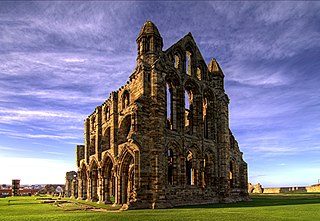
Saint Ælfflæd (654–714) was the daughter of King Oswiu of Northumbria and Eanflæd. She was abbess of Whitby Abbey, an abbey of nuns that were known for their skills in medicine, from the death of her kinswoman Hilda in 680, first jointly with her mother, then alone. Ælfflæd was particularly known for her skills in surgery and her personal attention to patients, as was Hilda, who was known for her personalized medical care.

Chelles Abbey was a Frankish monastery founded around 657/660 during the early medieval period. It was intended initially as a monastery for women; then its reputation for great learning grew, and when men wanted to follow the monastic life, a parallel male community was established, creating a double monastery.

Agilbert was the second bishop of the West Saxon kingdom and later Bishop of Paris. He is venerated as a saint within the Catholic Church, with his feast day falling on 11 October.

Louise Adélaïde d'Orléans was the second daughter of Philippe d'Orléans and Françoise Marie de Bourbon, a legitimised daughter of Louis XIV of France and his mistress, Madame de Montespan. She was an Abbess of Chelles.
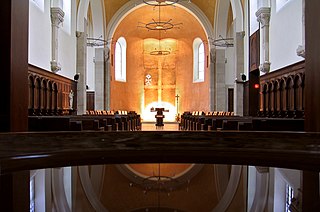
Jouarre Abbey is a Benedictine abbey in Jouarre in the département of Seine-et-Marne.

Marie Anne Éléonore Gabrielle de Bourbon was a daughter of Louis III de Bourbon, Prince of Condé and Louise Françoise, Princess of Condé. She was the Abbess of Saint-Antoine-des-Champs, an abbey in the Villejuif suburb of Paris.
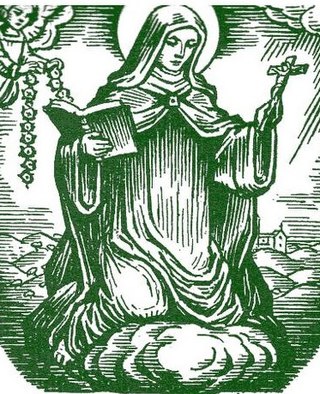
Saint Berthild, also known as Bertille or Bertilla, was abbess of Chelles Abbey in France.

Nivelles Abbey is a former Imperial Abbey of the Holy Roman Empire founded in 640. It is located in Nivelles, Walloon Brabant, Belgium.

Agilberta, also known as Aguilberta of Jouarre and Gilberta of Jouarre, is a Benedictine French saint, venerated in both the Roman Catholic Church and Antiochian Orthodox Church. She was a nun and the second abbess of the Jouarre Abbey, in the département of Seine-et-Marne. Agilberta was a relative of Ebrigisil and Ado, who founded Jouarre in 660. Her brother, Agilbert, was bishop of Paris. Agilberta's sister, Balda, was Jouarre's third abbess.

Balda of Jouarre was the third abbess at Jouarre Abbey in north-central France. She was a nun at Jourarre for many years, under her nieces Theodichildis and Agilberta, who were abbesses before her. Her nephew, Agilbert, was bishop of Paris. She might have been related to Sadalberga.

The Abbey of St Caesarius, at first called the abbey or monastery of St John, was a nunnery in the city of Arles in the south-eastern corner of the rampart. It was founded in 512 AD by Saint Caesarius of Arles, after whom it is now named. The abbey was suppressed in the French Revolution. Those that remained of the buildings were later used as a hospice; they are now adandoned.
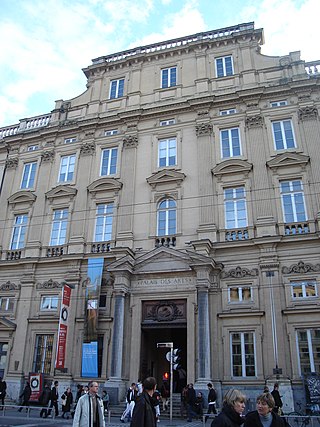
The Abbey of Saint-Pierre-les-Nonnains in Lyon, also known as the Abbey of the Dames de Saint-Pierre or simply Palais Saint-Pierre, is an ancient Catholic religious edifice that housed Benedictine nuns from the 10th century onwards, and was rebuilt in the 17th century. Closed during the French Revolution, the former abbey is now home to the Musée des Beaux-Arts de Lyon.

















